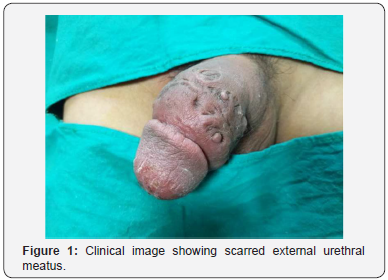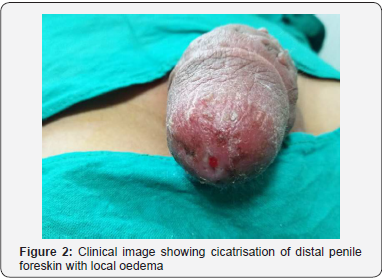Juniper Publishers- Open Access Journal of Case Studies
Post Circumcision Meatal Stenosis Causing Renal Failure: A Preventable and Disastrous Complication
Authored by Gaurav Garg
Abstract
Circumcision is commonly performed as a religious ritual in certain communities (Muslims, Jews) worldwide. It is a relatively safe procedure with very low complications rates (5-20%) when done by an expert healthcare professional. After 10 years of undergoing circumcision at his home, a 12-year-old Muslim boy presented with difficulty in voiding. On evaluation he was found to have a scarred pinpoint external urethral meatus, deranged renal function tests, bilateral moderate hydroureteronephrosis with right vesico-ureteric reflux (VUR). He underwent meatoplasty. At 6 months follow up the patient is voiding well with improvement in his kidney function parameters and resolution of VUR. In communities practicing ritual circumcision customary beliefs and lack of patient education often clash with healthcare services and pose challenges to individuals to obtain quality healthcare services resulting in neglect of disease with disastrous outcomes.
Keywords: Circumcision; Meatal stenosis; Renal failure
Introduction
Circumcision is commonly performed as a religious ritual in certain communities (Muslims, Jews) worldwide [1]. It is a relatively safe procedure with very low complications rates (5-20%) reported when done by an expert healthcare professional [2,3]. We herein report an extremely rare case of 12-year-old boy who developed renal failure secondary to meatal stenosis (MS) after circumcision.
Observations
A 12-year-old Muslim male, a resident of the rural area in Uttar Pradesh, northern India presented in July 2017 with a history of the poor urinary stream and straining on micturition for last 10 years. He also gave a history of intermittent puffiness of the face, anorexia and decreased urine output. He revealed a non documented history of undergoing circumcision at his home by an unskilled person at an age of 2 years. He denied any history of fever, oral ulcers, joint pain, diarrhea, drug intake, alopecia, immunization. There was no history suggestive of constipation and lower limb weakness. The patient intermittently took ayurvedic oral medications prescribed by a local health practioner in last 10 years however he never underwent any investigations such as ultrasonography (USG) or retrograde urethrogram (RGU). On examination, the child was of short built with stable vital signs (BP-102/56mmHg, PR-96/min). There was mild pallor with facial puffiness. Examination of the penis revealed circumsized penis with pinpoint external urethral meatus (calibration with 6 Fr feeding tube could not be done) and cicatrisation of the distal penile skin (Figure 1 & 2). Focused neurologic examination and other systemic examination was unremarkable. Blood serum chemistries revealed mildly raised erythrocyte sedimentation rate (ESR)-22 mm during the first hour, anemia with normal cell counts (haemoglobin-7.3g/dl, total leucocyte count-9000/mm3, platelet count-2.5 lacs), deranged renal function tests (blood urea-85mg/dl, serum creatinine-3.1mg/dl) and normal serum electrolytes (Na-136mEq/l, K-4.4mEq/l). The estimated glomerular filtration rate (GFR) as calculated by MDRD equation was 29ml/min/1.73m2 (normal > 90ml/min/1.73m2) [4]. Rheumatoid factor, anti-nuclear antibody, and C-reactive protein levels were within normal limits. Urine analysis revealed 2-4 pus cells/HPF with the absence of RBCs and proteins. Urine culture was sterile after 48 hours of incubation. Uroflowmetry revealed decreased peak flow rates (8ml/s), decreased average flow rate (5ml/s) with raised post void residual urine (PVR) of 220ml. Ultrasonography (USG) of abdomen revealed thickened trabeculated bladder with bilateral moderate hydro-ureteronephrosis. A retrograde urethrogram (RGU) was performed which showed meatal stenosis with rest of anterior urethra normal (Figure 3). To complete the study a micturating cystourethrogram (MCU) was performed which revealed right sided vesicoureteric reflux (VUR). Based on clinical examination and investigations reports, a provisional diagnosis of meatal stenosis with secondary bladder changes with bilateral hydroureteronephrosis with chronic renal failure was made. After proper counseling and consent, he underwent dorsal meatoplasty with “inverted V” incision under general anesthesia [5]. Postoperative period was uneventful. At 6 months follow up the patient is passing urine with a good stream (peak urinary flow> 15ml/s, average urinary flow- 12ml/s, post void residue < 50ml). His kidney function parameters have also improved with a decrease in blood urea (34mg/dl) and serum creatinine (1.2mg/dl) levels. A repeat USG, MCU revealed resolution of bilateral hydro-ureteronephrois and right VUR.



Discussion
Childhood circumcision is routinely performed in certain communities in India as a religious ritual. When done by expert healthcare professionals the procedure is relatively safe [6]. Various minor complications can occur with circumcision such as bleeding, infection, wound dehiscence etc that can be managed conservatively and have no chronic sequalae [6,7] However some complications like excess loss of penile skin, urethro-cutaneous fistula and meatal stenosis (MS) can have a long-term impact on sexual and urinary function [6,7]. There is conflicting data on the estimated incidence of post circumcision MS. In a recent metaanalysis done by Morris et al, the authors found that the estimated incidence of MS is < 1%. [8] However, this study underestimates the magnitude of the MS problem in circumcised boys by several orders of magnitude by including a myriad studies which rely on overtly incomplete register data with short-term follow-up, based on which any estimate of the absolute risk of MS will be misleading. While universally acknowledged to be extremely rare in intact boys, a recent clinical study which published data relying on direct penile examination from as varied geographical areas as the United States, the United Kingdom, Bangladesh and Iran, suggested that MS will develop in somewhere between 5% and 20% of boys circumcised during infancy or childhood [3]. The cause of MS after circumcision has been proposed to be due to frenular artery ligation, surgical wound infection or as a result of chemical meatitis [9]. The former mechanism of MS may be more relevant in our case. The risk of MS may be potentially reduced by application of petroleum jelly after performing circumcision [8]. Another author proposed that frenular artery preservation during circumcision or use of alternative techniques such as preputial plasty may decrease chances of meatal stenosis after circumcision [9]. In India, there is a social obligation to undergo ritual circumcision in certain communities as soon as a boy is born. Despite the availability of expert healthcare professionals parents prefer to get procedures like circumcision done by untrained persons with or without anesthesia at their homes/local centers. In the present context of ritual, Muslim circumcision, preputioplasty is hardly relevant, because this surgery is not an option for religious purposes. Adherence to routine aseptic surgical principles during circumcision may also reduce the postoperative complications including MS. Factors such as illiteracy, rigid social beliefs, and low socioeconomic status may prevent the people living in rural/remote areas to obtain quality healthcare. In the present case, the patient underwent circumcision at an age of 2 years by an untrained health professional at his home. The cause of MS in the present case may be inadvertent ligation of the frenular artery during circumcision leading to urethral mucosal ischemia supplemented by local wound infection. In extreme cases, untreated MS may result in upstream upper tract changes and deterioration of renal function. To the best of our knowledge, this is the first case report on post-circumcision MS causing chronic renal failure.
Conclusion
Meatal stenosis is a rare and preventable complication of circumcision. Neglected cases of meatal stenosis may rarely cause renal failure. Adherence to aseptic surgical principles during circumcision may reduce the post-operative complications. Extensive education and promotion of available healthcare practices must be done among communities in which ritual circumcision is routinely performed.
For more articles in Open Access Journal of Case Studies please click on: https://juniperpublishers.com/jojcs/index.php



No comments:
Post a Comment